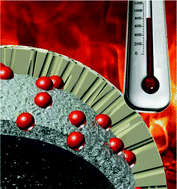Engineering microencapsulation of highly catalytic gold nanoclusters for an extreme thermal stability†
Abstract
A synthetic strategy for the microencapsulation of ultra-small gold nanoparticles toward the development of a novel nanoreactor is reported. In this case, it is shown that the catalytic activity of Au nanoclusters as small as 0.8 nm remains unaffected after a thermal treatment up to 800 °C in air. This is accomplished through the deposition and further coating of the gold nanoparticles in a void/silica/Au/silica configuration where the nature of the alternate shells can be tuned regardless of each other's porosity and the size of the embedded metal nanoparticles. Such spatial confinement suppresses the growth of the gold nanoclusters and thus preserves their catalytic properties. In this way, a remarkable compromise between the immobilization and the accessibility to the metal nanocatalyst can be met. Furthermore, these nanoreactors are found to be colloidally stable in simulated body fluids which also makes them suitable for biomedical applications. The implementation of hollow nanoreactors containing highly dispersed and immobilized but accessible ultra-small metal nanoparticles constitutes a promising alternative in the search for model catalysts stable under realistic technical conditions.


 Please wait while we load your content...
Please wait while we load your content...